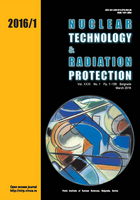
EVALUATION OF THE NATURAL RADIOACTIVITY LEVEL OF NIGERIAN TAR SAND DEPOSITS, EASTERN DAHOMEY BASIN, SOUTHWESTERN NIGERIA
Pages: 79-88
Authors: Adewale Akinmosin, Michael A. Oladunjoye, and Fabian Essein
Abstract
The specific activities of natural radionuclides in twenty seven samples collected from the eastern Dahomey basin in southwestern Nigeria were evaluated. Experimental results were obtained by using a 3'' ± 3'' sodium iodide NaI(Tl) detector. A major trace element assessment of the samples was made by Inductively Coupled Plasma Mass Spectrometry techniques. Gamma ray radioactive standard sources, 137Cs and 60Co, were used to calibrate the measurement system and the International Atomic Energy Agency SOIL-375 radioactive standard source was also used to analyze and compute the specific activities of desired natural radionuclides. Three radioelements, viz. 238U, 232Th and 40K, were identified in the samples with the following specific activities of 238U ranging from 9.88 ± 4.70 Bq/kg to 69.15 ± 12.37 Bq/kg with an average of 26.50 ± 7.18 Bq/kg; 232Th from 12.78 ± 5.16 Bq/kg to 36.86 ± 13.35 Bq/kg with an average of 22.77 ± 4.28 Bq/kg; 40K ranging from 189.82 ± 79.51 Bq/kg to 518.77 ± 119.54 Bq/kg with an average of 297.69 ± 16.21 Bq/kg. The result was compared with the world mean values of 35, 30 and 400 Bq/kg, respectively, specified by the United Nations Scientific Committee on the Effects of Atomic Radiation. The mean result obtained for the radium equivalent, total absorbed dose rate, external hazard index, internal hazard index, and the annual effective dose equivalent, were 79.90 Bq/kg, 38.50 µSv/h, 0.22 Bq/kg, 0.29 Bq/kg, and 47.22 µSv, respectively. With respect to radiological risk to human health, the absorbed gamma dose rate in air was estimated to be in the range of 21.7 ± 0.4 to 155.7 ± 2.2 µSv/h; the outdoor annual effective dose equivalent was evaluated to vary from 26.6 ± 0.4 to 190.9 ± 2.7 µSv with the arithmetic mean value of 79.06 ± 33.23 µSv and compared to the worldwide effective dose of 70 µSv. Also, the values of the radium equivalent and the external hazard index for all samples in the study area were found to be lower than the accepted safety limit value of 370 Bq/kg and equally below the limit of unity, respectively. The results indicate that, at present, the radiation hazard from radionuclides in all samples analyzed is within permissible limits.
Key words: tar sand, radionuclide, radiation, dose rate, absorbed rate, hazard, environment
FULL PAPER IN PDF FORMAT (5.23 MB)
